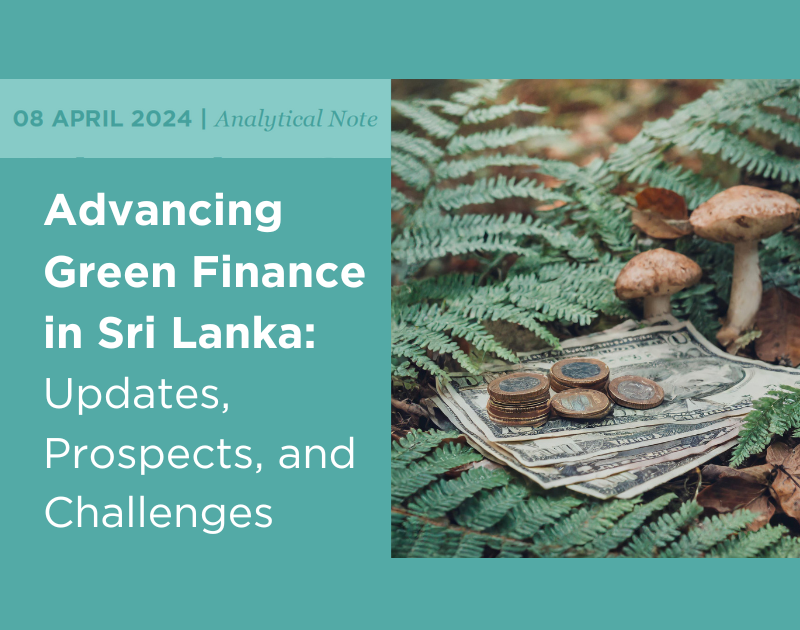
- Home
- Knowledge Insights
- To What Extent Do Sri Lankan Financial Institutions Integrate Environmental Considerations?
Beach cleanups, tree planting programmes, and commitments to recycling. These are some of the common ways in which Sri Lankan financial institutions typically market World Environment Day, falling each year on the 5th of June. Yet, there are major outstanding questions as to whether the country’s financial institutions are effectively orienting themselves to meet the environmental challenges emerging in the country, and ensure that capital flows in the direction needed to foster a nature-positive economic recovery for Sri Lanka.
There is an urgent need to connect intent with action. Globally there is to be a growing disconnect between what financial institutions say and what they do. In an incisive 2023 report on ‘Green lending: do banks walk the talk?’, staff at the European Central Bank observed that among 100+ institutions they studied in the Eurozone, banks which portray themselves as more environmentally-conscious lend more than others to ‘brown industries’, and that there is sharp disconnect between the extent of ‘green disclosures’ by the banks and their actual lending to green projects.
Sri Lankan regulators and industry players should take notice, because the disconnect appears in Sri Lanka too – albeit not studied as empirically as in the Eurozone. Simply adding the colour green to an institution’s logo, or the mention of environmental principles in an Annual Report message by the Chairman or CEO, does not demonstrate advanced and holistic adoption of environmental integration in practice. Some early research on some of these aspects for Sri Lankan financial institutions (FIs) are emerging.
A recent assessment by Centre for a Smart Future (CSF) of environmental integration in Sri Lanka’s financial services industry showed that of the 56 financial institutions (FIs) that were assessed (refer methodological notes i and ii), 22 firms demonstrated environmental integration intent (note iii), with only 12 of them refer to adherence to national policy frameworks and guidelines (note iv), and of them 7 refer to international guidelines (note v). Moreover, only 4 FIs mention any environmental targets in alignment with a strategy or regulatory guidance. The research also found that just 8 FIs had adopted an internal policy or strategy focused on the environment, while 12 reported having dedicated internal resources (for instance, a “climate task force”, “ESG team” with emphasis on the environment, a “sustainability officer”, or other environmental related committee, sub-committee, or management team).
Encouragingly, 12 FIs reported taking steps to build staff capacity building on environmental integration. It was revealing that not a single FI mentioned having an external inquiry/complaint/ grievance mechanism related to its ‘ESG’ or ‘environmental practices’, which is a vital component in building credibility in, and stakeholder engagement in making improvements to, its activities. Basic environmental impact reporting seems to be more widespread, though, with 27 of 56 FIs explicitly reporting one or more of the following: electricity consumption, water consumption, paper consumption, GHG emissions, carbon footprint, renewable energy produced, etc. But moving beyond these basic tenets, the research found little evidence that Sri Lankan lenders systematically assess environmental impacts and risks in granting credit facilities – just 5 of 47 lending institutions. The research also explored whether FIs indicate that they quantify/measure environmental and/or climate risks in their portfolio, and just 2 FIs indicate they categorize sectors most vulnerable to climate risk, while 2 FIs indicate they review environmental risks such as ‘Transition risk’ and ‘Physical risk’ in their portfolio.
Download summary findings in a slide deck here, and a shareable infographic here.
Methodological Notes:
i) We defined ‘Environmental integration’ as the extent to which firms regard the environment in their financial and non-financial business decisions, and utilized a bespoke assessment tool with criteria informed by global and local frameworks and knowledge (Sustainable Banking and Finance Network ‘ESG Integration’ pillar; Road Map for Sustainable Finance in 2019; and SBFN Sri Lanka Financial Sector Country Progress Report 2022.
ii) For selection of FIs for the review, we used the Global Industry Classification Standard (GICS) among CSE-listed firms, and the data sources were the latest available Annual Reports of these firms at the time of conducting the research during late 2023/early 2024, followed by some In-depth Interviews with industry leaders to validate selected aspects of the findings.
iii) Assessed by the Chairmans’ or CEOs’ Annual Report messages mentioning aspects like “ESG” (with a specific reference to environmental issues), “environmental consideration(s)”, and “ESMS (Environmental Services Management System)”.
iv) Mentions either the CBSL Sustainable Finance Roadmap or the Green Taxonomy.
v) Mentions one or more of the following: Task Force on Climate-related Financial Disclosures (TCFD) recommendations; Global Reporting Initiative (GRI) Sustainability standards; GRI standards from (Global Sustainability Standards Board); Sustainability Accounting Standards Board (SASB).


